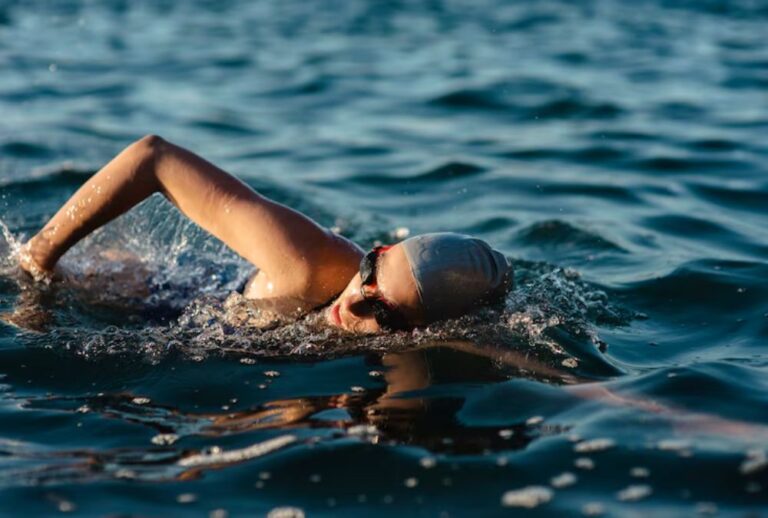New to open water swimming? This beginner-friendly guide covers everything you need to know before taking the plunge—from choosing the right gear and mastering technique to essential safety tips. Whether you’re swimming in a lake, river, or ocean, this blog will help you gain confidence, stay safe, and truly enjoy the open water experience. Dive in and discover the joy of swimming beyond the pool!

Introduction: Taking the Plunge into Nature’s Pool
For many fitness enthusiasts, open water swimming for beginners can feel like venturing into uncharted waters—both literally and metaphorically. But this invigorating sport offers freedom, connection with nature, and a full-body workout that’s hard to beat. Whether you’re transitioning from a pool or diving in fresh, this guide will ease your journey.
Unlike pool swimming, open water swimming introduces unpredictability—currents, temperatures, visibility, and wildlife. That’s why preparation is essential. With the right open water swimming tips, gear, and mindset, you’ll quickly grow comfortable and confident in the open water.
Why Try Open Water Swimming?
- Natural Connection: Swim in lakes, rivers, and oceans with minimal human-made interference.
- Mental Clarity: The calm and vastness of open water offers therapeutic benefits.
- Fitness Gains: Builds endurance, muscle strength, and cardiovascular health.
- Challenge Factor: Test yourself against nature’s elements—it’s exciting and empowering.
Getting Started: Open Water Swimming for Beginners
1. Start Slow and Safe
If you’re new to the sport, don’t head straight into the deep blue. Instead:
- Start in calm waters like a local lake or managed swimming spot.
- Go with a friend or join an open water swimming group.
- Choose shallow areas until you build confidence.
2. Get Comfortable in a Wetsuit
Wearing a wetsuit helps you stay warm, adds buoyancy, and protects against minor abrasions. If you’ve never worn one:
- Try it out in a pool first to get used to the snug fit.
- Ensure it’s made for swimming, not surfing or diving.
Essential Gear for Open Water Swimming
1. Wetsuit
A thermal wetsuit helps maintain your core temperature in cold water.
2. Bright-Colored Swim Cap
Increases visibility for safety—many organized swims require it.
3. Goggles
Choose ones with anti-fog and UV protection. Tinted lenses are ideal for sunny conditions.
4. Tow Float
Highly recommended for open water swimming safety. It provides buoyancy and makes you visible to boats and rescuers.
5. Earplugs and Nose Clips (Optional)
Great for those sensitive to cold water or prone to ear infections.
Open Water Swimming Safety: What Every Beginner Should Know
Open water swimming safety should always be your top priority. Here are must-follow precautions:
1. Never Swim Alone
Even if you’re experienced, conditions can change quickly. Swim with a buddy or let someone know your location and expected return time.
2. Know Your Limits
Understand how far you can go and turn back before fatigue sets in. Avoid pushing yourself too hard.
3. Study the Water
Before entering:
- Look for currents, waves, and wind patterns.
- Check the water temperature.
- Identify potential hazards (e.g., rocks, algae, jellyfish).
4. Acclimatize Slowly
Ease into cold water gradually to prevent cold water shock. Breathe deeply and move slowly at first.
5. Check Weather Conditions
Storms, strong winds, and extreme cold can turn an ideal swim into a dangerous one.
Mastering Technique: Open Water Swimming Tips
Swimming efficiently in open water is a different ballgame. Here are some open water swimming tips to enhance your performance:
1. Learn to Sight
In a pool, you have lanes. In the wild? Nothing. Sighting is the act of lifting your head to see where you’re going. Try:
- Lifting your eyes every 6–10 strokes.
- Spotting a landmark (tree, buoy, building) as your guide.
2. Breathe Bilaterally
Breathing on both sides helps you adjust to waves, currents, and wind direction. It also balances your stroke.
3. Draft Behind Another Swimmer
Save energy by swimming just behind or beside someone—like cyclists do. Just be respectful of their space.
4. Keep a Steady Rhythm
Avoid frantic strokes. A smooth, controlled pace reduces fatigue and improves efficiency.
Where to Practice: Ideal Locations for Beginners
Start with designated swim spots known for safety and calm waters. Some beginner-friendly options include:
- Supervised lakes with lifeguards.
- Sheltered coastal bays.
- Dedicated open water swimming parks.
Avoid open seas or rivers with strong currents until you’re more experienced.
Mental Preparation: Overcoming Fear
Many new swimmers feel anxious—especially in deep or dark water. Here’s how to overcome fear:
1. Float First
Before swimming, just float. It helps build trust in your buoyancy and calms nerves.
2. Focus on Your Breathing
Panic often comes from erratic breathing. Practice slow, rhythmic breaths.
3. Visualize Success
Positive visualization before a swim can boost your confidence.
Joining a Community: Learn and Grow Together
Joining an open water swimming club or Facebook group can:
- Keep you motivated.
- Help you learn from others’ experiences.
- Offer group swim opportunities and safety in numbers.
Look for local meetups or virtual forums. It’s a great way to stay informed about new locations, gear, and seasonal swims.
After the Swim: Recovery and Warm-Up Tips
Don’t forget the post-swim essentials:
- Dry Off Quickly: Carry a microfiber towel and change out of wet gear fast.
- Warm Drinks: Tea or coffee helps raise your core temperature after cold water exposure.
- Stretch It Out: Gentle stretches aid muscle recovery and reduce soreness.
Seasonal Swimming: Adapting Through the Year
Spring/Summer
- Water is warmer and days are longer.
- Start early in the season to gradually adapt.
Autumn/Winter
- Invest in a thermal wetsuit and neoprene accessories.
- Consider cold water dips rather than long swims.
- Always have someone nearby, especially when swimming in low temperatures.
Common Myths About Open Water Swimming
1. “It’s Only for Hardcore Athletes”
Wrong! People of all ages and fitness levels enjoy open water swimming. Start small and build gradually.
2. “It’s Too Dangerous”
With proper precautions, it’s no more dangerous than any outdoor activity.
3. “You Need Expensive Gear”
A wetsuit and a good pair of goggles can go a long way. You can always upgrade over time.
Final Thoughts: Dive Into Adventure
Whether you’re searching for a new hobby, want a full-body workout, or crave outdoor connection, open water swimming for beginners opens up a world of possibilities. With the right gear, safety knowledge, and technique, you’ll be gliding through natural waters with confidence and joy.
There’s no better time to start. Embrace the unknown, learn along the way, and most importantly—enjoy every splash.
Frequently Asked Questions
Is open water swimming safe for beginners?
Yes, if proper precautions are followed—never swim alone, wear safety gear, and choose calm, supervised waters.
Do I need to wear a wetsuit?
It’s highly recommended, especially in cold water, for warmth and buoyancy.
How do I overcome fear of deep water?
Start in shallow water, practice floating, and gradually build exposure to deeper areas with a friend.
What is the best time to swim in open water?
Early mornings are ideal—waters are usually calm, and it’s easier to spot wildlife and boaters.


